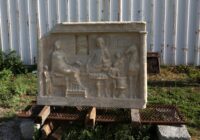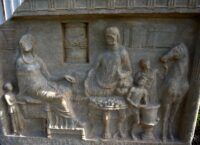 A carved funerary stele dating to the 1st century has been unearthed in the ancient Greek city of Parion, Kemer Village, in northwestern Turkey’s Çanakkale province. It was discovered in the town’s southern necropolis in an area which had been damaged by mechanical diggers during construction of a primary school in 2004. Many of the graves were damaged in the process, but the stele and burial chamber of Tomb 6 were found in comparatively good condition covered with five large stones.
A carved funerary stele dating to the 1st century has been unearthed in the ancient Greek city of Parion, Kemer Village, in northwestern Turkey’s Çanakkale province. It was discovered in the town’s southern necropolis in an area which had been damaged by mechanical diggers during construction of a primary school in 2004. Many of the graves were damaged in the process, but the stele and burial chamber of Tomb 6 were found in comparatively good condition covered with five large stones.
The stele is approximately three feet square and features a funerary banquet scene set inside an architectural border of fluted columns left and right. To the left is a seated female figure attended by a female servant (disproportionately small to distinguish attendants from their masters). Above her to the left is a calathus, a basket type used to hold skeins of wool or bring in the fruit harvest that was associated with women, marriage and fertility.
 The central figure is a reclining man. Before him is a sturdy mensa Delphica, a tripod table with legs carved to look like animal legs. The table is heavy with fruit. To his right are two servants, one serving a beverage from a large krater, one groom with, presumably, the master’s horse. Above the servants to the right are a chest and box, representing the household’s wealth.
The central figure is a reclining man. Before him is a sturdy mensa Delphica, a tripod table with legs carved to look like animal legs. The table is heavy with fruit. To his right are two servants, one serving a beverage from a large krater, one groom with, presumably, the master’s horse. Above the servants to the right are a chest and box, representing the household’s wealth.
A Latin inscription on the bottom of the stele identifies the couple in the relief: “Lucius Furnius Lesbonax, who was freed by Lucius, had this burial stele built for himself and his wife, Furnia Sympnerusa.”
Four burials containing the remains of 10 individuals were discovered around Tomb 6. One was a child, the other nine were adults. Each individual was buried with their own separate grave goods.
Pointing out that the stele is a significant find, [excavation leader Professor Vedat] Keleş said: “This stele showed us that the southern necropolis of Parion was heavily used during the Roman and earlier periods. At the same time, when we look at the condition of the tomb stele and the city, it shows us that the ancient city was a rich one in the Roman period, as it was a colonial city.”
“The names on the stele are also very important. For instance, Lesbonax is not a Latin name. His wife’s name is also not a Latin name. These are Greek names. We can even say that Lesbonax was someone who lived on the island of Lesbos. We understood that they were slaves and were later given Roman citizenship. We understood that when the Romans came to this city, they enslaved those who were here and then gave them citizenship,” he added.